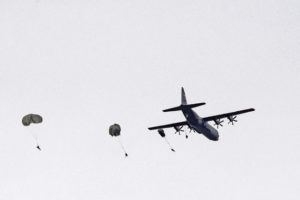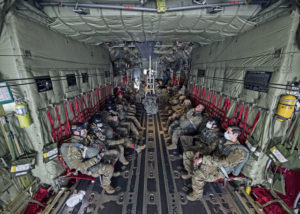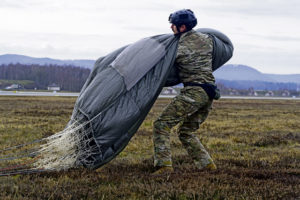
Despite the namesake, airspace remains a great untamable mass to the Air Force. Many favorable variables must come together to make a successful flight, and many teams must cooperate to make a successful airdrop.
“The sky, even more than the sea, is an unforgiving environment,” said Master Sgt. Jim Burke, 435th Contingency Response Squadron airfield manager.
Without the collaboration of several agencies, including the 37th Airlift Squadron, 86th Operations Support Squadron, and the 5th Quartermaster Company, the successful personnel air drop of 30 435th Contingency Response Group and 5th QM personnel on Ramstein airfield Feb. 18 would not have been possible.
By February, jumping had become a necessity for the 435th CRG. Airborne personnel are required to jump every quarter to remain current on their training and have availability to deploy anywhere in the world at any time.
“Jumping out of an aircraft at 1,000 feet while the aircraft’s going 130 knots with a parachute and a reserve requires a certain skill set,” said Burke. “All skills are perishable, so it’s important to keep them current.”
Due to COVID-19 guidance and weather cancellations, many airborne personnel have been unable to drop since October. Another cancellation in February prompted the 435th CRG jumpmaster team to reach out to multiple agencies for a short-notice drop on Ramstein’s airfield.

To be able to drop, first you have to make sure the airfield is clear, and on a runway that managed about 28,000 operations in 2019 that can be a difficult task. The 86th OSS personnel working in the air traffic control tower were indispensable in making the drop happen.
“Clearing the airfield is not exceedingly difficult, but some (real-world) aircraft push the (time) windows,” said Master Sgt. Matthew Cutshall, 86th OSS senior watch supervisor. “We have to try to accommodate them to the maximum extent possible.”
Additionally, the 86th OSS was required to publish a notice to Airmen informing them in advance of the activity.
To jump out of the aircraft you also need… an aircraft. The 37th Airlift Squadron provided one C-130J Super Hercules aircraft and their crew for the Feb. 18 flight. The 86th Airlift Wing Plans and Programs section was also necessary in getting the plan approved through wing leadership. The 5th QM provided parachutes for airborne personnel.
The 435th CRG also had a team on the ground to establish the drop zone marker, monitor wind speeds, and coordinate with other agencies and pilots on whether it was safe for personnel to drop.
All these agencies came together to make the jump of approximately 30 personnel possible, and Burke is happy to call the jump a success.

“Every jump you walk away from is a good jump,” Burke said.
Moreover, every jump is different. The vast number of combined variables in airspace can make a seemingly tame journey to earth life-threatening in an instant.
Regardless, parachuting is a necessary skill, as one of the 435th CRG’s missions is to establish air mobility or logistics operations anywhere in the world. Jumping allows airborne personnel to keep the mission going.
Overall though, Burke believes it’s one of the best ways to commute.
“Airborne is the most exciting, terrifying and painful way you could possibly get to work,” Burke said, “but I love it.”







